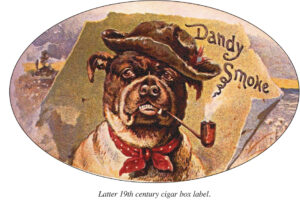 By Robert Reed
By Robert Reed
Histories are more full of examples of fidelity of dogs than friends. – Alexander Pope
The dog, man’s best buddy, has long been heralded with artifacts reflecting the close relationship of master and mutt.
Everything from precious Staffordshire to colorful cigar labels bear historic witness to that enduring affection. Cookie jars, folk art carvings, and foundry renderings all speak to the tie of human and tail-wag- ging friend.
Historians often note that high bred dogs were so popular in the middle 18th century England and nearly all of the porcelain factories were busily producing them. Typically a pug dog might be featured. The small and compact breed was identifiable with its square muzzle, smooth coat, and tightly curled tail.
Early examples were often of salt glaze or agateware. Some depicted the pug dog on a small rectangular base, with various under glazes applied.
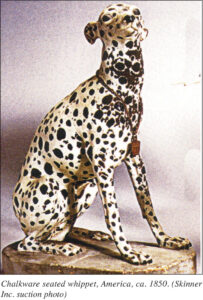 Among those dog figurals of that time the pug was by far the most popular image in the Staffordshire region of England. Another Staffordshire favorite was the greyhound. Elsewhere in England during the latter 18th and early 19th centuries choices among porcelain makers also included various hounds, poodles, and spaniels. Eventually “dogs of every breed were made in England’s porcelain factories including sporting dogs,” according to Katharine McClinton author The Complete Book of Small Antiques Collecting. This variation also extended to Dalmatians and later the whippet and poodles.
Among those dog figurals of that time the pug was by far the most popular image in the Staffordshire region of England. Another Staffordshire favorite was the greyhound. Elsewhere in England during the latter 18th and early 19th centuries choices among porcelain makers also included various hounds, poodles, and spaniels. Eventually “dogs of every breed were made in England’s porcelain factories including sporting dogs,” according to Katharine McClinton author The Complete Book of Small Antiques Collecting. This variation also extended to Dalmatians and later the whippet and poodles.
Typically the dog of choice was depicting in a sitting position with head up and ears erect. However makers sometimes had the dog in a reclining position. “Some dogs were portraits, but most (figurals) had a quaint appearance,” noted McClinton, “although their coloring was close to nature.”
Early in the 19th century Staffordshire dogs were being produced in pairs to sit on the mantle on the fireplace facing each other. Often they referred to at the time as comforters because the sight of the familiar dogs was said to be comforting to the viewer. By the 1820s such comforter pairs could be found in various sizes ranging from just over three inches in height to some 18 inches in height.
Familiar dogs could also be famous dogs. Legend has it that Queen Victoria’s own spaniel, called Dash, was the inspiration for great numbers of Staffordshire dogs. In the 1840s a renowned artist cast a remarkable bronze of Napoleon’s famed bloodhound David.
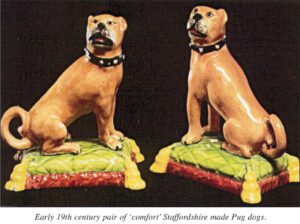 Porcelain dogs for the most part remained basic throughout most of the 19th century, with no more than a single dog depicted. However there were elaborations which might include a dog with puppies, a dog with a game bird in its mouth, or a dog chasing another animal.
Porcelain dogs for the most part remained basic throughout most of the 19th century, with no more than a single dog depicted. However there were elaborations which might include a dog with puppies, a dog with a game bird in its mouth, or a dog chasing another animal.
In the United States during the 1850s there were chalk ware and yellow ware being fashioned by talented craftsmen. Erwin Christensen described one such yellow ware pottery dog in The Index of American Design. It had been at the United States Potteries in Bennington, Vermont. Christensen noted:
“The dog is an example of ceramic sculpture, illustrating Victorian love over ornamentation. Glaze containing colored matter was spattered on, and the potter was so delighted with it that he was not troubled by the unrealistic mottling.”
Writing a full century later, Christensen further added, “here too is the sentimental appeal of the pet poodle so beloved by our grandparents.”
There were a number of dog images created from Rockingham glazed pottery during the 1850s as well. Small but efficient Rockingham potteries stretched from New England to the Midwest. Glazed pottery whippet figures were a specialty of Edward Tunnicliff of Zanesville, Ohio during that era. Tunnicliff sometimes used raised lettering on a platform just beneath the sitting dog, giving both his name and town.
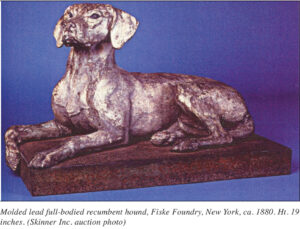 During the latter part of the 19th century in America the image of the distinguished dog could be found as high at the top of the barn as a metal weathervane. Closer to the ground the companion dog was popular topic of itinerant carvers of the 1870s. In the Pennsylvania region of the country noted carver William Schimmel was known for his detailed renderings of dogs and other animals. A Schimmel friend, Aaron Mounts, also used soft pine wood to create small but highly detailed carvings of eagles, squirrels, and dogs.
During the latter part of the 19th century in America the image of the distinguished dog could be found as high at the top of the barn as a metal weathervane. Closer to the ground the companion dog was popular topic of itinerant carvers of the 1870s. In the Pennsylvania region of the country noted carver William Schimmel was known for his detailed renderings of dogs and other animals. A Schimmel friend, Aaron Mounts, also used soft pine wood to create small but highly detailed carvings of eagles, squirrels, and dogs.
Dogs began to have commercial appeal too in the marketplace.
The image of a striking dog, usually a bulldog, began to appear on cigar box labels of the 1870s, 1880s and beyond in the United States. Improvements in the lithographic printing process allowed for richly colored illustrations. The artists were creative as well frequently ‘dressing’ the dog images with a hat, vest, jacket, bandana, or eye patch. Further the dog may be smoking a cigar or perhaps playing cards.
Antique historians and experts Ralph and Terry Kovel note in their best-selling book, The Label Made Me Buy It, that the idea of using bull- dogs on product labels became popular in Eng- land during the Victorian era and then spread to the United States.
They note that dog images were eventually used on a vast array of products, not only cigars and chewing tobacco but everything from brooms to vegetables. Some artists, including Cassius Marcellus Coolidge, specialized in depicting dogs engaged in human activities to make them even more appealing on prod- uct labels.
Elsewhere in the late 19th century the dog might be featured on pastel paintings by known or unknown artists, or even as the moving part of a mechanical bank. The Speaking Dog, for example, featuring a little girl and her dog, was one of many cast iron banks manufactured in the late 1880s by the Stevens Foundry in Cromwell, Connecticut.
Carved wooded dogs continued to be popular with folk artists early in the 20th century, but other materials were also pressed into use to honor the faithful animal. Sometime in the 1920s or 1930s a folk artist in Ohio used native limestone to sculpture a charming dog. The 14 inch work sold in recent years at one of the East coast’s leading auction galleries for a substantial price.
There were glass dogs too.
Starting in the 1930s the Cambridge Glass Company began producing their noble Bridge Hound in colors anging from amber to royal blue. In the 1950s the Heisey Glass Company produced both Airedale and Scottie dogs in crystal glass. Early in the 1950s the Imperial Glass Company provided adorable bulldog, Scottie, and terrier dogs in milk glass.
That was of course just some of so much more. Additionally there have been ashtrays, book-ends, doorstops, ink blotters, pinback buttons, and puzzles just to name a few. The family pooch, whether a distinguished breed or a mere mutt, remains endearing in artful image as well as real life.

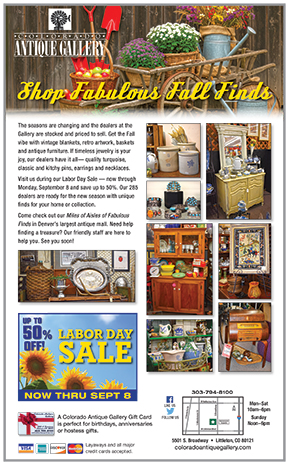

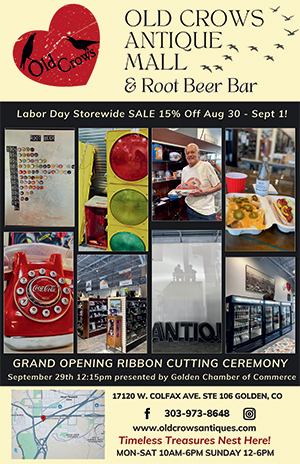





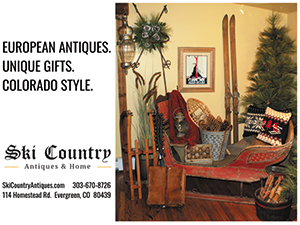
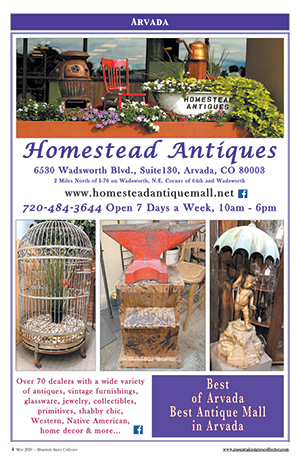
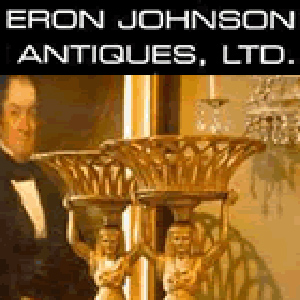

Follow Us